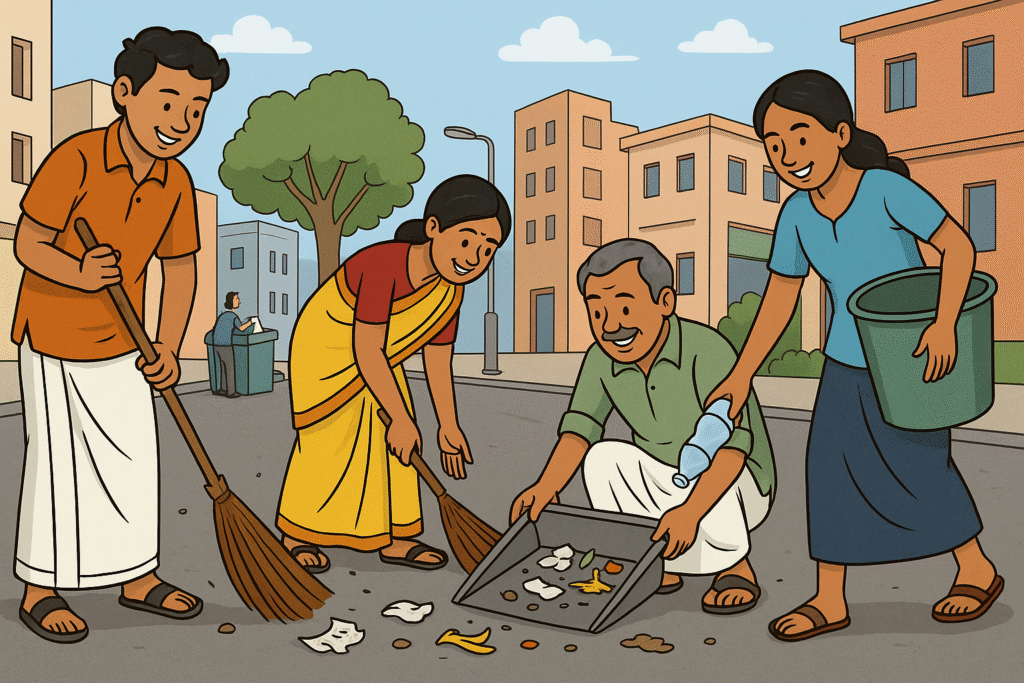Clean Village is not just about looking tidy—it’s a powerful step toward healthier living, stronger community values, and a better future.
In villages like ours, where nature and people live side by side, maintaining cleanliness is a responsibility we all share. When each person makes small changes daily, the whole village becomes a cleaner, healthier place.

Let’s explore 10 simple but powerful daily habits that can help us maintain a clean village and lead to healthier lives.
1. Start with Your Home Surroundings
A clean village starts with clean homes. Sweeping the front yard, removing standing water, and keeping gutters clean prevents mosquito breeding and keeps the area neat.
Encourage every family to clean at least 10 feet outside their compound daily.
2. Dispose of Waste Properly
Never throw waste into open land or water bodies. Use designated waste bins and promote the idea of waste segregation (biodegradable and non-biodegradable). If your village doesn’t have a system, start one with community support.
Related: Learn more about Proper Waste Segregation (DoFollow)
3. Say No to Plastic
Ban single-use plastic in homes, shops, and temples. Encourage cloth bags and steel containers.
Children can be great ambassadors for this—teach them the importance of saying “no” to plastic every day.
4. Clean Roads and Paths Regularly
Daily sweeping of roads and paths (especially near schools, temples, and bus stops) keeps dust and waste away. Rotating volunteer groups or paid helpers can be organized for this, but it works best when everyone contributes.
5. Plant and Protect Green Spaces
Planting trees and flowering plants along the roadside or in unused corners adds beauty and helps the environment.
Assign different areas to local groups or school children to maintain.
6. Keep Public Toilets Clean
If your village has public toilets, cleaning them daily must be a priority. Good hygiene reduces the spread of disease and makes the whole village more livable, especially for visitors.
Helpful Resource: Swachh Bharat Mission (DoFollow)
7. Avoid Spitting and Urinating in Open Spaces
This may seem small, but such habits make the environment unhygienic and disrespectful.
Start awareness campaigns and install signs in public areas. Provide access to clean public toilets.
8. Manage Animal Waste Properly
Animals are part of village life, but their waste must be cleaned regularly. Assign areas for cattle and use the dung for organic composting to benefit crops and gardens.
9. Educate Children on Cleanliness
Clean village habits must begin at home and in school. Teach children the value of not littering, washing hands, and cleaning their surroundings.
Run monthly competitions or ‘cleanest home’ awards to make it fun.
10. Conduct Monthly Village Clean-Up Drives
Involve youth groups, elders, and women’s associations in monthly cleaning events. Clean temple grounds, school areas, and unused corners. Celebrate cleanliness as a shared goal, not a burden.
Internal Link: Check out our blog on Reviving Our Traditions: Why Our Village Culture Matters
Building a Clean Culture: The Role of Each Person
Creating a clean village isn’t about waiting for someone else to act. It’s about what each of us does daily.
The village becomes clean not because of one person’s effort—but through the power of collective responsibility.
From shopkeepers to school students, each has a role:
- Keep shops clean and waste-free
- Set an example by picking up litter
- Support composting and recycling
- Educate others who are unaware
Even small habits like carrying your own water bottle, reusing old containers, or not littering during festivals go a long way.
Digital Tools for Cleanliness Awareness
Your website nandipulam.com can be a great platform to:
- Share pictures of clean-up drives
- Announce “Clean Street of the Month”
- Educate villagers on hygiene with videos
- Promote youth initiatives and green campaigns
You can even launch a “Clean Nandipulam Pledge” for families to sign and follow!
Final Thoughts: Clean Village, Healthy Lives
In the end, a Clean Village brings Healthy Lives—less sickness, better relationships, pride in where we live, and a beautiful environment for future generations. It starts with us. Each step you take today adds up to a cleaner tomorrow.
Let’s make Nandipulam a model village of cleanliness and health, one habit at a time.
















